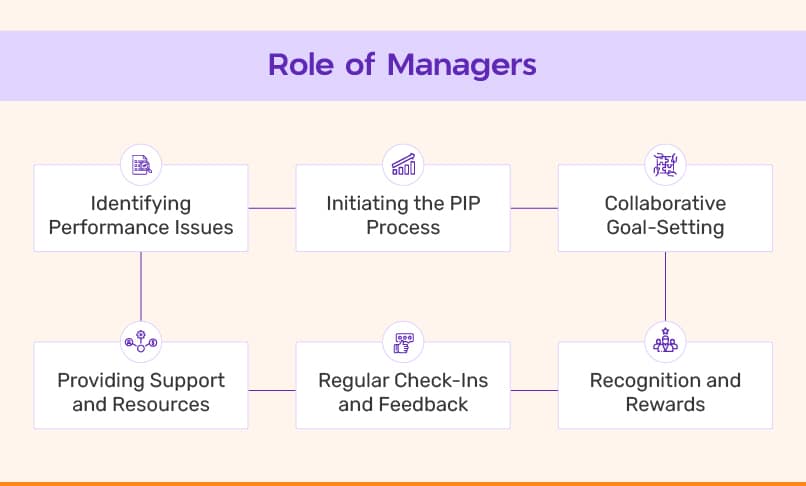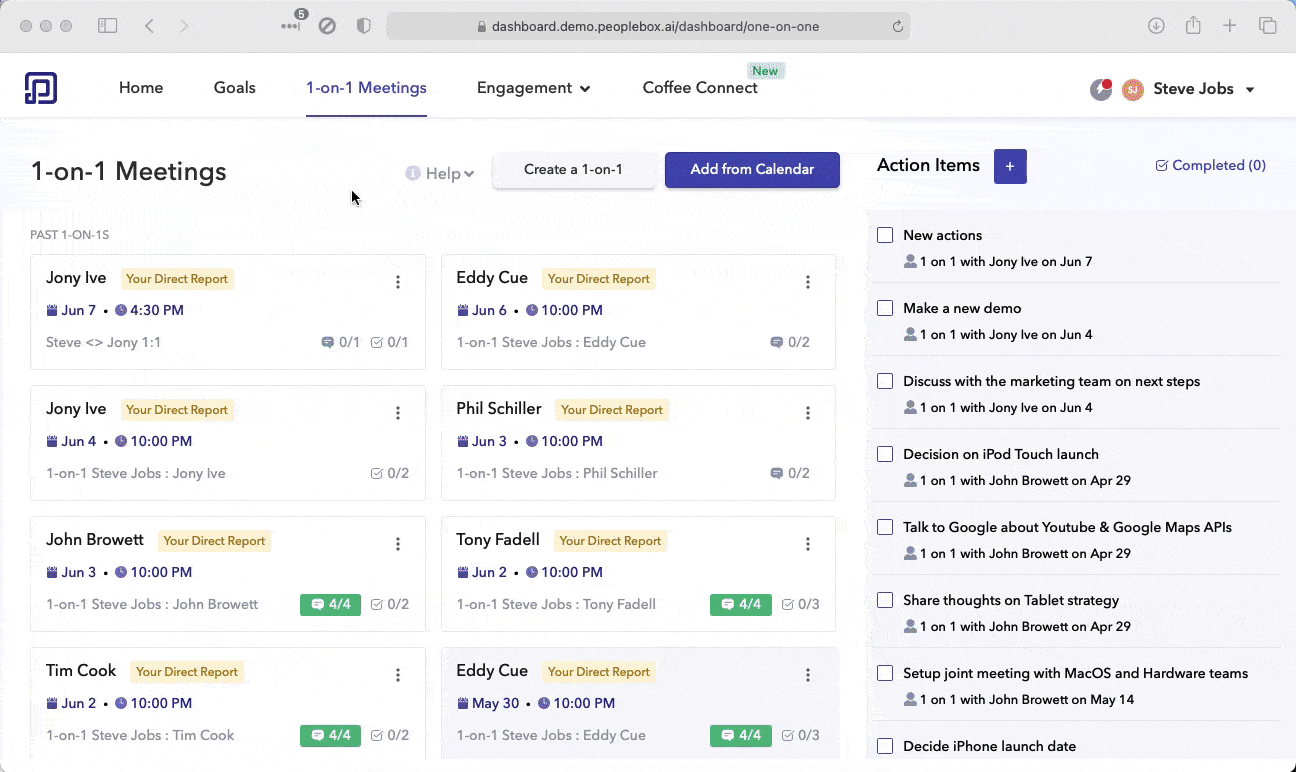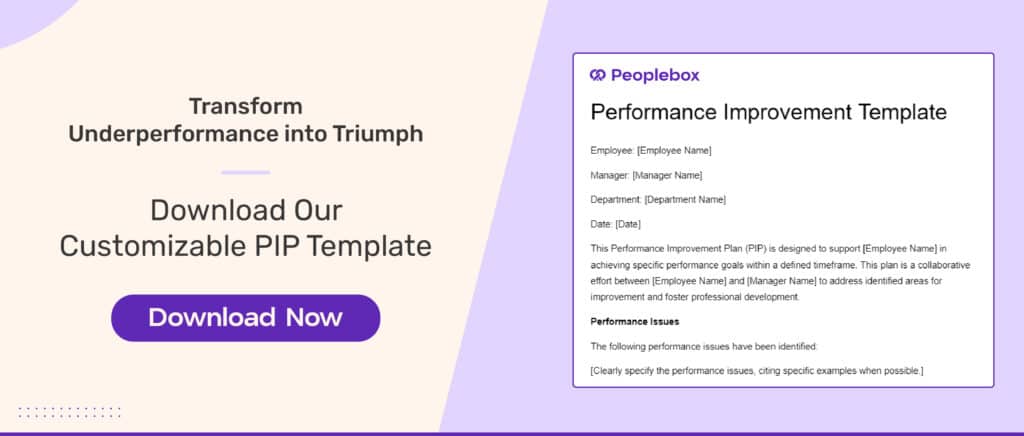When it comes to running a successful business, ensuring that employees consistently meet performance expectations is crucial. A well-designed Performance Improvement Plan (PIP) serves as a powerful tool to address performance issues, set clear objectives, and foster employee growth and development.
However, creating an effective PIP requires a structured approach. In this blog, we walk you through the process of drafting a PIP from scratch, and share a fee template you can use to guide your employees through the development process.
Key Takeaways
✔️ Performance Improvement Plans (PIPs) are a structured way to address employee performance issues and help them improve. They can be used when coaching and feedback haven’t yielded results.
✔️ PIP benefits both employees and employers. They help employees get back on track and employers retain valuable talent.
✔️ Creating an effective PIP requires collaboration between managers and HR. This includes setting clear goals, providing support, and tracking progress.

What is a Performance Improvement Plan?
A Performance Improvement Plan (PIP) is a formal document outlining specific steps an employee needs to take to improve their performance. The purpose of a PIP is to help employees address and overcome performance issues, ultimately leading to their success and growth within the organization.
PIPs are initiated when feedback and performance coaching haven’t yielded desired results, aiming to collaboratively enhance performance with consequences if improvement isn’t achieved.
What is Included in a Performance Improvement Plan?
Performance improvement plan typically details the specific areas needing improvement, sets clear goals with deadlines, and outlines the support provided (like training or mentorship). Regular check-ins ensure progress is monitored and feedback is given.
The plan also clarifies potential consequences for not meeting goals, while acknowledging improvements made along the way. We talk more about this later in this article.
But, how can you decide if someone needs to be put on a PIP? We’ll tell you!
When is a Performance Improvement Plan Needed?
Recognizing when a Performance Improvement Plan is necessary is crucial for managers and HR professionals. Here are some key indicators:
🔻 Consistent Underperformance
Employees consistently fail to meet established performance standards or expectations over an extended period.
🎯 Missed Deadlines or Targets
Failure to complete tasks or achieve objectives within designated timeframes, indicating potential productivity or time management issues.
😓 Decline in Work Quality
Observable decrease in the quality of work produced by the employee, leading to errors, inefficiencies, or poor customer service.
🗣️ Feedback from Team and Clients
Negative feedback from colleagues, team members, or clients regarding the employee’s performance, professionalism, or behavior.
🤬 Behavioral Issues
Display of disruptive or unprofessional behavior in the workplace, such as conflicts with coworkers, insubordination, or lack of teamwork.
😐 Failure to Adapt or Learn
Inability or unwillingness to adapt to changes in job requirements, technology, or procedures, hindering personal and organizational growth.
🫂 Changes in Personal Circumstances
Personal issues such as health issues, family problems, or significant life events may contribute to a decline in performance and signal the need for support or intervention.
🔁 Repetitive Performance Discussions
Ongoing discussions or interventions regarding the employee’s performance without sustained improvement, indicating the need for a more structured approach.
❌ Misalignment with Organizational Goals
Lack of alignment between the employee’s performance and the organization’s objectives, vision, or values, potentially impeding progress toward strategic goals.
Why is an Employee Performance Improvement Plan Important?
1. Identifying and Addressing Performance Issues 😟
PIPs provide a structured framework for identifying performance issues and addressing them proactively. By clearly outlining areas of improvement and setting specific goals, PIPs help employees understand expectations and work towards meeting them.
2. Clarifying Expectations 🎯
PIPs ensure that expectations regarding performance standards, goals, and timelines are communicated clearly to employees. This clarity helps prevent misunderstandings and ensures alignment between employee performance and organizational objectives.
3. Providing Support and Resources 📚
PIPs offer employees the support and resources they need to succeed. Whether it’s access to training programs, mentorship, or additional resources, PIPs ensure that employees have the tools necessary to improve their performance.
4. Promoting Accountability 🙋
PIPs establish accountability by setting measurable goals and timelines. Employees are held accountable for meeting these objectives, and the consequences of not meeting them are clearly outlined. This accountability fosters a culture of responsibility and ownership within the organization.
5. Facilitating Professional Development 🪴
PIPs serve as opportunities for professional development. By identifying areas for improvement and providing targeted support, employees can enhance their skills and capabilities, ultimately contributing to their long-term career growth.
6. Preserving Talent 🧠
Rather than immediately resorting to termination for underperformance, PIPs offer a chance for employees to improve and succeed within the organization. This approach can help retain valuable talent and minimize employee turnover costs.
Let’s take an example to understand the concept better.
Performance Improvement Plan Example
Julia, a project manager at a marketing agency, consistently missed project deadlines, causing delays in client deliverables. During her performance review, her manager, Alex, decided to implement a performance improvement plan to address the issue.
1. Objective Assessment: Julia’s repeated failure to meet project deadlines was negatively impacting client satisfaction and team efficiency.
2. Root Cause Analysis: Discussions with Julia revealed that her struggles stemmed from poor time management and prioritization due to an increased workload.
3. Concrete Goals and Timelines: Using the OKR framework, Julia’s PIP set specific goals, including attending a time management workshop, implementing learned strategies, and reducing project delays by 20% within three months.
4. Collaborative Development: Alex and Julia collaboratively developed the action plan, ensuring Julia’s input was considered and the goals were clear and measurable.
5. Support and Resources: Julia received access to a time management training program and was paired with a senior project manager as a mentor.
6. Regular Check-Ins and Feedback: Bi-weekly check-ins were scheduled to discuss Julia’s progress, address challenges, and provide guidance.
7. Consequences and Rewards: The PIP outlined clear consequences, such as further performance reviews, and potential rewards, like positive recognition and career advancement opportunities, for successful completion.
Throughout the PIP, Julia attended the time management workshop, applied new strategies, and achieved a 15% reduction in project delays. The collaborative and supportive nature of the PIP effectively addressed Julia’s performance issues and contributed to her professional development.
Doesn’t that sound great?
What actually made the difference here is how Alex, the manager, played an active role in Julia’s professional development.
Let’s quickly look at how the HR (you) and the managers can play a significant role in implementing the PIP.
What is the Role of Managers and HR in Implementing a PIP?
The successful implementation of a performance improvement plan requires collaboration and effective communication between managers and Human Resources (HR). Each plays a distinct yet interrelated role in ensuring that the PIP achieves its intended outcomes.

🔍 Identifying Performance Issues
Managers are typically the first to notice performance issues among their team members. They play a crucial role in identifying areas that need improvement and understanding the specific challenges faced by employees.
👍 Initiating the PIP Process
Once performance issues are identified, managers collaborate with HR to initiate the PIP process. They provide insights into the specific goals and expectations for improvement.
🧑🤝🧑Collaborative Goal-Setting
Managers work closely with employees to collaboratively set clear, measurable objectives within the PIP. This involves open communication, understanding the employee’s perspective, and ensuring that the goals align with organizational objectives.
Pssst! Did you know, Peoplebox provides a easy to use OKR platform that lets you and your team members set goals effortlessly. Don’t believe us? Try it yourself!
🫂 Providing Support and Resources
Managers are responsible for ensuring that employees have the necessary support and resources to meet the goals outlined in the PIP. This may involve providing additional training, assigning mentors, or allocating relevant tools and resources.
📆 Regular Check-Ins and Feedback
Managers conduct regular check-ins with employees to monitor progress, offer constructive feedback, and address any challenges that arise. These check-ins are essential for maintaining open communication and adjusting the PIP as needed.
🏆 Recognition and RewardsManagers play a role in recognizing and rewarding improvements in performance. Positive reinforcement can motivate employees to continue making progress and contribute positively to the workplace culture.

📃 Developing and Documenting the PIP
HR professionals work alongside managers to develop the formal PIP document. They ensure that the plan is structured, clearly outlines expectations, and aligns with the organization’s policies and procedures.
🧑⚖️ Legal Compliance
HR is responsible for ensuring that the PIP complies with legal requirements. They help mitigate legal risks associated with performance management, ensuring fairness and adherence to employment laws.
🫂 Employee Advocacy
HR serves as an advocate for employees, ensuring that the PIP is fair, transparent, and supportive. They act as a neutral party, mediating any concerns or disputes that may arise during the PIP process.
🧑🏫 Providing Training and Support
HR may coordinate training programs or provide additional resources to support employees in meeting the goals of the PIP. They ensure that employees have access to the tools needed for improvement.
👋 Termination Assistance
In cases where the employee is unable to meet the goals outlined in the PIP, HR plays a role in facilitating termination procedures while ensuring compliance with company policies and legal requirements.
Now that we have discussed the important role you play in the PIP process, let us look deeper at how you can craft a solid performance improvement plan in your organization.
How to Create Performance Improvement Plan?
A well-crafted Performance Improvement Plan is a valuable tool for organizations aiming to enhance employee performance and achieve overall success.
Here are key steps for creating an effective performance improvement plan:
1. Conduct an Objective Assessment
Begin the first step by conducting a thorough and objective assessment of the employee’s performance issues. Identify specific areas that require improvement and define clear expectations and standards that are currently unmet.
2. Analyze the Root Causes
Next, look into the underlying factors contributing to performance gaps. Consider both professional and personal elements that might impact the employee’s ability to meet expectations. Identifying the root causes enables targeted interventions.
3. Set Concrete Goals and Timelines
Establish clear, measurable objectives for improvement. Define a realistic time frame for goal attainment, providing a roadmap for both the employee and the management to track progress. If you’re unsure how to set goals, our blog post on how to set goals for a performance review can help.
Peoplebox’s OKR management platform lets you easily set, track, and manage your goals, all within the platform.

4. Develop the Improvement Plan Collaboratively
Involve the employee in the creation of the plan. Encourage open communication to understand their perspective and concerns. Determine what is the acceptable performance. A collaborative approach fosters a sense of ownership and commitment to the improvement process.
5. Provide Support and Resources
Provide the necessary tools, training, and support to help the employee meet their goals. Ensure access to resources that facilitate improvement, empowering the individual to succeed in their professional development.
6. Schedule Regular Check-Ins and Feedback with Employee
Schedule regular meetings and one-on-ones to monitor progress. These interactions offer opportunities for constructive feedback, acknowledging improvements and addressing any challenges encountered. Regular communication is key to a dynamic and responsive improvement process.
With Peoplebox, you can effortlessly schedule regular 1-on-1s with your employees. Additionally, if you’re unsure about which questions to ask, Peoplebox offers suggested talking points to facilitate meaningful and impactful check-ins.

7. Outline Consequences and Rewards
Clearly outline the consequences if the employee fails to meet the outlined goals. Simultaneously, recognize and reward improvements in performance. This balanced approach establishes accountability while reinforcing positive behavior.
Now that you know what all to include in a PIP, let’s move on to the most important part of the process— letting your employees know.
How to Communicate the Performance Improvement Plan to Employees?
Introducing a performance improvement plan to an employee is a sensitive process that requires thoughtful communication. Effectively conveying the purpose and objectives of the plan is crucial for its success. Here are some strategies you can implement.
Conducting a Constructive Feedback Session
Delivering feedback is an essential part of any PIP conversation. Here are some tips to ensure it’s constructive and impactful:
👉 Focus on specific behaviors and actions
Avoid vague generalizations like “your performance isn’t up to par.” Instead, pinpoint specific areas where improvement is needed, using concrete examples and data to illustrate your points.
👉 Maintain a positive and encouraging tone
Frame the conversation as an opportunity for professional development, not punishment. Emphasize your belief in the employee’s potential and your commitment to supporting them in reaching their goals.
👉 Actively listen and give the employee a chance to respond
Encourage open dialogue and acknowledge their perspective. Listen attentively to their concerns and questions, and address them directly.
👉 Use “I” statements
Instead of accusatory “you” statements, phrase your feedback as “I’ve observed” or “I’m concerned about.” This helps personalize the message and avoids placing blame.
👉 Focus on the future
Offer specific and actionable steps the employee can take to improve. Define clear goals and performance expectations, and create a plan together to achieve them.

Addressing Concerns and Offering Support
It’s natural for employees to have concerns about a PIP. Here’s how you can address them and offer the necessary kind of support:
💡 Anticipate common concerns
Be prepared to address questions about job security, career progression, and the overall purpose of the PIP. Explain how the plan is designed to help them succeed and offer reassurances if their job is not at risk.
💡 Provide resources and support
Clearly outline the resources available to the employee, such as training programs, mentorship opportunities, or access to additional tools or technology. This demonstrates your commitment to their success.
💡 Communicate regularly
Schedule regular check-in meetings to track progress, provide feedback, and answer any questions. Maintaining open communication fosters trust and keeps the employee engaged in the process.
💡 Emphasize the role of HR
Encourage employees to reach out to HR if they have any concerns or questions about the PIP process. HR can provide additional support and guidance, ensuring fair and transparent communication throughout.
Free Performance Improvement Plan Template
Creating a PIP can seem like a daunting task, especially if you’re unsure where to begin. To simplify this for you, we have developed a Free Performance Improvement Plan Template.
This template is designed to guide you through each step of the PIP process, making it easier to outline objectives, identify root causes, and establish measurable goals.
By using this PIP template, you can streamline your efforts and ensure that you’re addressing performance issues effectively while supporting employee development.
Download our free template today and take the first step toward creating a structured and impactful Performance Improvement Plan!

🥨 Conduct 360 Degree Performance Reviews with Peoplebox
At Peoplebox, we redefine the performance review experience through our innovative and comprehensive 360 degree performance feedback system. Change your approach to performance assessments by embracing a holistic perspective that includes feedback from peers, managers, subordinates, and even self-evaluations.

With Peoplebox performance management software, you can streamline your performance review process, gather valuable insights, and empower your employees to thrive.
Ready to take your performance reviews to the next level? Get started with Peoplebox today!







